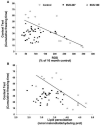Prevention of cognitive deficits and brain oxidative stress with superoxide dismutase/catalase mimetics in aged mice
- PMID: 18571288
- PMCID: PMC2865437
- DOI: 10.1016/j.neurobiolaging.2008.05.009
Prevention of cognitive deficits and brain oxidative stress with superoxide dismutase/catalase mimetics in aged mice
Abstract
Continuous decline in cognitive performance accompanies the natural aging process in humans, and multiple studies in both humans and animal models have indicated that this decrease in cognitive function is associated with an age-related increase in oxidative stress. Treating aging mammals with exogenous free radical scavengers has generally been shown to attenuate age-related cognitive decline and oxidative stress. The present study assessed the effectiveness of the superoxide dismutase/catalase mimetics EUK-189 and EUK-207 on age-related decline in cognitive function and increase in oxidative stress. C57/BL6 mice received continuous treatment via osmotic minipumps with either EUK-189 or EUK-207 for 6 months starting at 17 months of age. At the end of treatment, markers for oxidative stress were evaluated by analyzing levels of free radicals, lipid peroxidation and oxidized nucleic acids in brain tissue. In addition, cognitive performance was assessed after 3 and 6 months of treatment with fear conditioning. Both EUK-189 and EUK-207 treatments resulted in significantly decreased lipid peroxidation, nucleic acid oxidation, and reactive oxygen species (ROS) levels. In addition, the treatments also significantly improved age-related decline in performance in the fear-conditioning task. Our results thus confirm a critical role for oxidative stress in age-related decline in learning and memory and strongly suggest a potential usefulness for salen-manganese complexes in reversing age-related declines in cognitive function and oxidative load.
Copyright 2008 Elsevier Inc. All rights reserved.
Figures






Similar articles
-
Effects of the superoxide dismutase/catalase mimetic EUK-207 in a mouse model of Alzheimer's disease: protection against and interruption of progression of amyloid and tau pathology and cognitive decline.J Alzheimers Dis. 2012;30(1):183-208. doi: 10.3233/JAD-2012-111298. J Alzheimers Dis. 2012. PMID: 22406441
-
Reversal of age-related learning deficits and brain oxidative stress in mice with superoxide dismutase/catalase mimetics.Proc Natl Acad Sci U S A. 2003 Jul 8;100(14):8526-31. doi: 10.1073/pnas.1332809100. Epub 2003 Jun 18. Proc Natl Acad Sci U S A. 2003. PMID: 12815103 Free PMC article.
-
Attenuation of staurosporine-induced apoptosis, oxidative stress, and mitochondrial dysfunction by synthetic superoxide dismutase and catalase mimetics, in cultured cortical neurons.Exp Neurol. 2001 Sep;171(1):84-97. doi: 10.1006/exnr.2001.7747. Exp Neurol. 2001. PMID: 11520123
-
Salen Mn complexes mitigate radiation injury in normal tissues.Anticancer Agents Med Chem. 2011 May 1;11(4):359-72. doi: 10.2174/187152011795677490. Anticancer Agents Med Chem. 2011. PMID: 21453241 Free PMC article. Review.
-
Oxidative stress, aging, and central nervous system disease in the canine model of human brain aging.Vet Clin North Am Small Anim Pract. 2008 Jan;38(1):167-78, vi. doi: 10.1016/j.cvsm.2007.10.002. Vet Clin North Am Small Anim Pract. 2008. PMID: 18249248 Free PMC article. Review.
Cited by
-
Superoxide dismutase mimics: chemistry, pharmacology, and therapeutic potential.Antioxid Redox Signal. 2010 Sep 15;13(6):877-918. doi: 10.1089/ars.2009.2876. Antioxid Redox Signal. 2010. PMID: 20095865 Free PMC article. Review.
-
Voglibose and saxagliptin ameliorate the post-surgical stress and cognitive dysfunction in chronic anaesthesia exposed diabetic MCAo induced ischemic rats.IBRO Neurosci Rep. 2022 Nov 1;13:426-435. doi: 10.1016/j.ibneur.2022.10.009. eCollection 2022 Dec. IBRO Neurosci Rep. 2022. PMID: 36386599 Free PMC article.
-
Mitigation of radiation-induced lung injury with EUK-207 and genistein: effects in adolescent rats.Radiat Res. 2013 Feb;179(2):125-34. doi: 10.1667/RR2954.1. Epub 2012 Dec 13. Radiat Res. 2013. PMID: 23237541 Free PMC article.
-
Superoxide Dismutase Administration: A Review of Proposed Human Uses.Molecules. 2021 Mar 25;26(7):1844. doi: 10.3390/molecules26071844. Molecules. 2021. PMID: 33805942 Free PMC article.
-
Mitigating effect of EUK-207 on radiation-induced cognitive impairments.Behav Brain Res. 2017 Mar 1;320:457-463. doi: 10.1016/j.bbr.2016.10.038. Epub 2016 Oct 24. Behav Brain Res. 2017. PMID: 27789343 Free PMC article.
References
-
- Barnes CA, Markowska AL, Ingram DK, Kametani H, Spangler EL, Lemken VJ, Olton DS. Acetyl-1-carnitine. 2: Effects on learning and memory performance of aged rats in simple and complex mazes. Neurobiol. Aging. 1990;11:499–506. - PubMed
-
- Bruce AJ, Baudry M. Oxygen free radicals in rat limbic structures after kainate-induced seizures. Free Radical Biol. Med. 1995;18:993–1002. - PubMed
-
- Butterfield DA, Reed T, Perluigi M, De Marco C, Coccia R, Cini C, Sultana R. Elevated protein-bound levels of the lipid peroxidation product 4-hydroxy-2-nonenal, in brain from persons with mild cognitive impairment. Neurosci. Lett. 2006;397:170–173. - PubMed
-
- Calabrese V, Scapagnini G, Ravagna A, Colombrita C, Spadaro F, Butterfield DA, Giuffrida Stella AM. Increased expression of heat shock proteins in rat brain during aging: relationship with mitochondrial function and glutathione redox state. Mech. Ageing Develop. 2004;125:325–335. - PubMed
Publication types
MeSH terms
Substances
Grants and funding
LinkOut - more resources
Full Text Sources
Other Literature Sources

